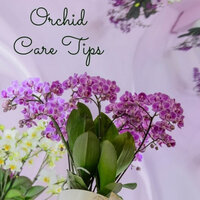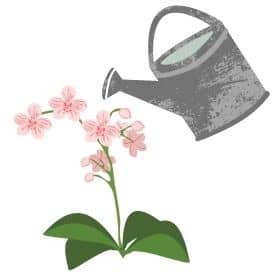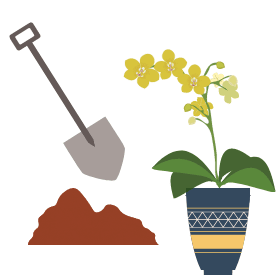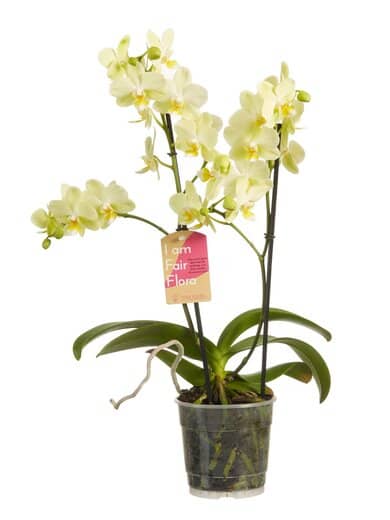-
The best tips to take good care for your orchid

The orchid is the most famous ornamental flower in our homes. This beautiful indoor plant is known for its beautiful flower with many different shapes and colours. The best known species in Spain is the phalaenopsis orchid. This is due to its long and frequent flowering.
You may have heard that orchids are notoriously finicky to care for, but we're here to challenge that notion. In reality, phalaenopsis orchids are surprisingly easy to care for, and with our guidance, you'll be well on your way to enjoying your beautiful blooms for a longer period of time, without worrying about neglecting their needs.
enjoy your orchid
Originally from Southeast Asia and Australia, orchids thrive in their natural habitats, often sprouting from tree trunks, rocky crevices, or well-draining soil rich in humus. As a houseplant, with proper care, you can appreciate its stunning blooms for a prolonged period. To maximize your enjoyment, place your orchid in a spot with abundant indirect light, avoiding direct sunlight, and you'll be treated to its breathtaking beauty for years to come. Surprisingly, caring for an orchid is not as demanding as you might think!

watering
This plant does not consume a lot of water, so you don't need to water it much. The plant only needs water when the soil is dry. Therefore, it is best for indoor orchids to give a splash of water every 10 days. Pour the water directly on the soil and not on the plant and especially not on the flowers, because when they get wet, brown spots may appear on their precious flowers. It does not like cold baths, so make sure the water is at room temperature. It is also preferable to water the plant in the morning. This way your orchid can better absorb the water.
The pot should be submerged in water so that the substrate is completely soaked and then the excess water should be drained off. Avoid letting the water stand in the pot. This can be detrimental to the roots of the plant. During the winter the plant enters its resting phase. At this time your orchid demands less water, so you can stop watering every 10 days and start watering every 14 days or so. Keep in mind that they do not like lime water.

Orchids tolerate underwatering much better than overwatering.
humidity
Being native to tropical climates, they need warmth and humidity. Orchids tend to grow in areas that are considerably more humid than your living room, dining room or bedroom, so it would not be a bad idea to occasionally spray rainwater on these tropical plants, mimicking their natural habitat and providing them with an invigorating mist of water vapour.
usa un sistema de riego para orquídeas
Some of the phalaenopsis orchids we offer in our online shop come with a special watering system. This method is a plastic cup-shaped container around the growing pot. This creates a water buffer under the pot. Due to the capillary effect, the plant absorbs the water, so it only needs to be watered once every 7 to 14 days.
the light
Where should I put my orchid? This is a question we answer very often. Put the orchid in a place with plenty of light, where it does not receive direct sunlight. Too much sunlight will make the plant duller in colour and damage or burn the leaves.
This houseplant is sensitive to drafts and prefers a consistent, stable environment. To ensure its well-being, it's best to keep it away from radiators and other heat sources, as this can cause damage and increase the risk of pests and diseases. Additionally, be mindful of placing the orchid near fruit baskets, particularly those containing bananas. These fruits emit a type of gas that can accelerate the plant's aging process, so it's best to keep them separate.
the ideal temperature

It is no secret: temperature regulates the rhythm of your orchid's life. If the temperature is too low it can slow down the vital rhythms, while too high a temperature will increase respiration and consequently hinder the plant's development. In general they need warmth, but be careful in summer. Your orchid also doesn't like 40℃ or having the air-conditioning on 'North Pole mode'. Here is our advice for the ideal growing temperature for the phalaenopsis orchid:
- maximum daytime temperature: 32℃
- minimum daytime temperature: 16℃
- minimum night-time temperature: 14℃
wilted orchids
What should you do when the flowers of your orchid fall off?
Don't worry if your orchid's flowers drop off - it's a common occurrence! Losing blooms doesn't necessarily mean you're not providing the right care for your orchid. After the blooming period, if a stem has lost all its flowers and is turning yellow, it's time to prune it. Unfortunately, new flowers won't regrow from the same stem. However, we recommend a simple solution: (as orchid experts, we advise this option).
- let the plant replenish itself by shortening the stem one centimetre above the first dormant bud (this will allow the dormant bud to develop into a flower bud). With this method, the new flowers will take longer to emerge (up to half a year), but the orchid will be more intensely coloured and the flowers will be stronger, or
- cut about 1 centimetre above the second or third dormant bud; this way a new bud will come out quickly.
If your phalaenopsis orchid is developing aerial roots, which grow out of the pot, this is a sign that the orchid is very much at ease. Leave these roots in touch, you do not have to put them back in the pot or cut them off.
repotting and transplanting orchids
To ensure your orchid thrives for years to come, we recommend repotting it every 2-3 years or when it becomes pot-bound. When repotting, use a high-quality orchid potting soil that is specially designed to promote healthy root growth. This lightweight soil will allow the roots to breathe and flourish. Before repotting, carefully remove any dead or damaged roots to prevent any potential issues. When transplanting your orchid, whether it's soon after purchase or after a few years, make sure to use a pot that is at least 20% larger than the previous one. This will give the roots ample room to expand and the plant plenty of room to grow.

It is preferable to repot in the spring, no later than June. In this period the orchid will have more strength to repair any damage done during repotting. We also suggest that you repot just before or after the flowering period. So that the plant's energy goes to the roots, rather than to the flowers.
orchid fertiliser
To support optimal growth and health, fertilize your orchid during the spring and summer months when it is actively growing. Avoid fertilizing during autumn and winter, as the plant will be dormant during this time. Applying fertilizer during dormancy may not provide any benefits and could potentially harm the plant.
Always use special fertiliser for phalaenopsis orchids and the right substrate. It is important to read the instructions on the package carefully before use to ensure the correct dosage for your orchid.
buy your favourite orchid
Looking for the perfect orchid to gift or add to your collection? Look no further than FlorEspaña! We have curated a stunning selection of top-quality orchids from esteemed nurseries in the Netherlands, ensuring you'll find the perfect one for your needs.

Get inspired on our social media with tips for decorating your home. Follow all the tips to enjoy and make the most of the art and beauty that your orchid, nature, will bring to your home!
No comments found.